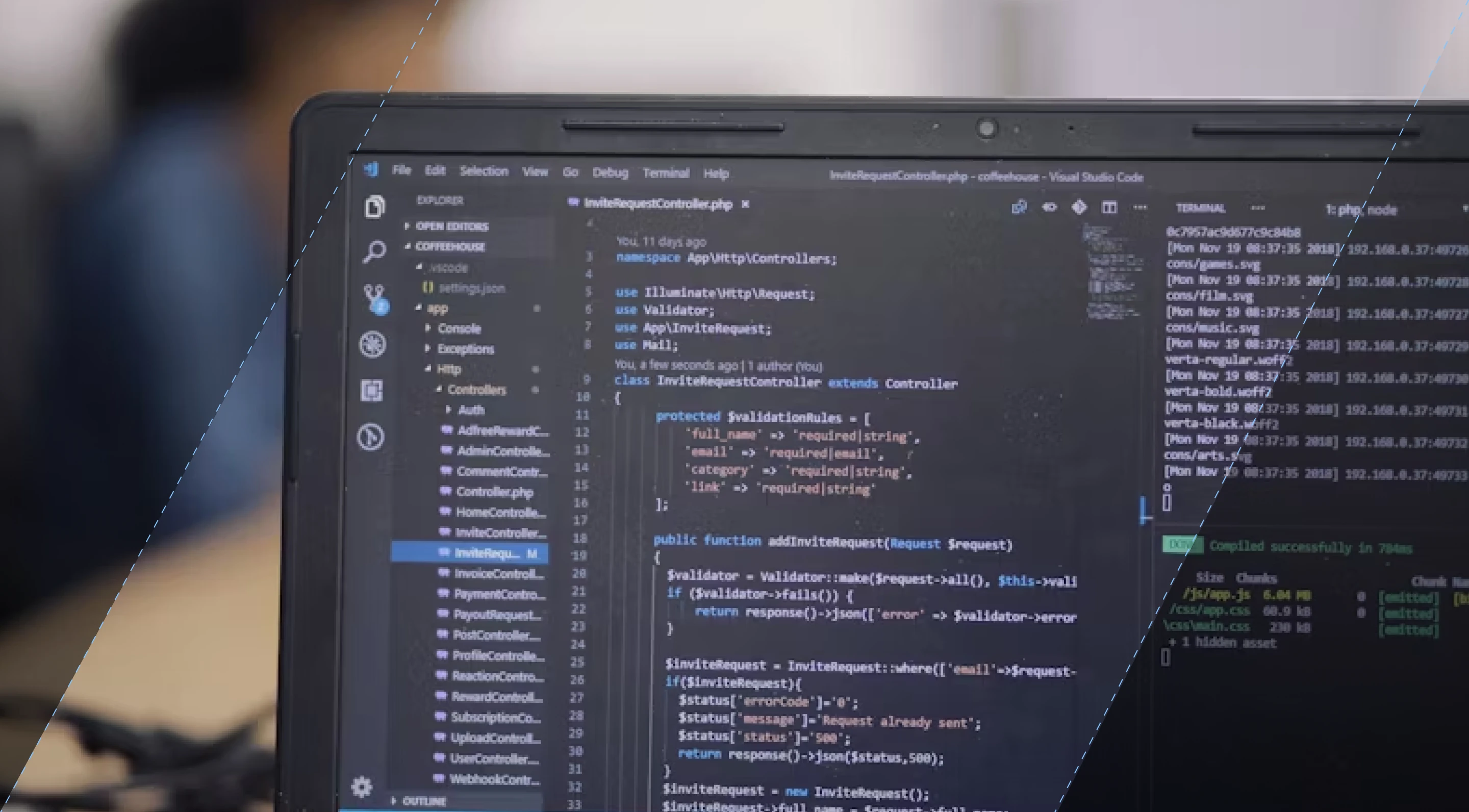SHARE
Headless Architecture: What You Need To Know

Contents
Contents
Businesses continuously face the challenge of adapting to new technologies to maintain a competitive edge. Headless architecture is a solution that can boost flexibility, scalability, and time to market for your websites and apps.
According to Kentico’s “State of Headless CMS Market” report, 53% of all respondents have experience with using headless content management systems (CMSs), and the rate of use has increased by 18% since 2020. This growing adoption demonstrates the importance of this innovative approach for businesses looking to optimize their digital presence.
This innovative approach separates the presentation layer from the CMS, enabling more dynamic and personalized user experiences across various platforms. In this post, you will learn what headless architecture is, explore its advantages, and understand why it is increasingly becoming a key consideration for businesses eager to optimize their digital presence.
Key Takeaways:
- Headless architecture fundamentally separates your frontend presentation layer from your backend logic, enhancing flexibility and allowing for independent updates and scaling of each component.
- By decoupling your frontend and backend, headless architecture lets you adopt new technologies and update existing features without a complete system overhaul, maintaining your relevance and competitiveness.
- The use of APIs to connect your frontend and backend allows for more efficient data handling and distribution across various platforms, which improves your website performance and scalability, especially during high-traffic situations.
What Is Headless Architecture?
Headless architecture is a way to build websites and apps where the front part that users interact with (what you see on your screen) is kept separate from the back part that manages the data (where your information is stored). This setup allows you to change and improve the user-facing part without having to adjust the data handling part, making it easier and faster to update and manage different platforms or devices.
Traditionally, digital platforms have used monolithic CMSs where the frontend and backend are tightly integrated. This setup often made updates cumbersome and scaling difficult. In contrast, headless architecture decouples your frontend and backend, connecting them through APIs. This separation allows for flexible frontend development, enabling you to deliver content across different platforms such as websites, mobile apps, and IoT devices without needing a backend redesign.
Unlike monolithic systems where updates or changes can disrupt entire operations, headless architecture allows for more agile adjustments and enhancements, minimizing downtime and improving overall digital agility. With headless architecture, you can choose the frontend technology that best suits your design needs and user experience goals, as the backend operates independently via APIs. By adopting headless solutions, you can enhance your operational agility and easily integrate new technologies, maintaining a competitive edge while meeting evolving customer expectations.
Advantages of Headless Architecture
Now that you understand the basics of headless architecture, let’s explore how adopting this approach can significantly benefit your business operations and customer interactions.
Flexibility and Future-Proofing
Headless architecture offers unparalleled flexibility, making it easier for you to stay ahead of your competitors. By separating your frontend presentation from backend data management, you can update or change your user interfaces without disrupting the entire system. This architectural style supports easier adoption of new technologies as they emerge, without requiring a complete overhaul of your existing backend systems. It also allows you to experiment with and deploy new customer-facing features much more rapidly and adapt quickly to market changes and consumer demands.
Improved Developer Experience
When you use headless architecture development teams are not confined to the specific programming languages or frameworks that traditional CMS systems often impose. This flexibility speeds up the development process, as developers can utilize modern frontend frameworks like React, Vue.js, or Angular, which are designed to create dynamic, responsive user interfaces. This can lead to increased productivity and more creative freedom in crafting user experiences, while backend developers can focus on optimizing the system’s core functionality.
Scalability and Performance
Decoupling the frontend from the backend lets you scale your operations more effectively. Since content delivery is handled through APIs, it can be distributed seamlessly across multiple channels and devices, reducing the load on your original content management system. This setup improves your website performance and user response times, even under high-traffic conditions. Headless architecture can also handle more user requests simultaneously, making it a robust solution for your business if you are experiencing rapid growth or preparing for scalability.
Omnichannel Content Distribution
One of the strongest advantages of headless architecture is its capability to support omnichannel content distribution, especially for e-commerce businesses. A Salesforce study found that 67% of customers will use several channels to carry out one transaction.
Regardless of where your content needs to be displayed —be it mobile apps, desktop browsers, smart devices, or any other internet-connected platform — your headless CMS can deliver appropriate content through APIs.
By enabling consistent and personalized content delivery across all platforms, headless architecture significantly enhances the customer experience, helping you to build stronger relationships with your audience no matter where they interact with your brand.
Headless Architecture in Practice
Adopting headless architecture involves navigating several practical challenges and considerations to maximize its benefits. While the advantages are compelling, understanding the potential hurdles is essential for successful implementation.
Integration with Existing Systems
One of the initial challenges you might face when transitioning to headless architecture is integrating it with your existing legacy systems. Many platforms weren’t designed to be separated into frontend and backend services. Therefore, integrating a headless CMS with these systems can require significant technical effort and strategic planning. It often involves developing custom APIs or middleware that can bridge the gap between the old and new systems, allowing for smooth data flow and functionality without disrupting your business operations.
Managing APIs
APIs are the backbone of headless architecture and play a crucial role in the functionality and effectiveness of your decoupled systems. You must diligently manage these APIs to make sure they are secure, efficient, and capable of handling the required load. This includes regular updates, monitoring for potential security vulnerabilities, and optimizing performance to handle increased traffic and data exchanges as your business scales.
Security Considerations
With your increased reliance on APIs, security becomes a paramount concern in headless setups. Each endpoint potentially opens up a new avenue for security threats that require robust security protocols to protect. Implementing measures such as API gateways, thorough authentication, and authorization checks are critical to safeguarding your system against data breaches and unauthorized access.
Choosing the Right Tools
When selecting the right headless CMS and frontend framework for headless architecture, consider the following:
- Headless CMS Features: Opt for a CMS with robust API capabilities, multi-language support if needed, and adaptable content modeling. Popular choices include Contentful, Sanity, and Strapi.
- Frontend Frameworks: Choose frameworks like React, Angular, or Vue.js, known for their responsiveness and strong community support. Consider the learning curve, ecosystem compatibility, and integration ease.
- Scalability: Verify the tools can accommodate growing traffic and data needs. Check scalability features and performance metrics.
- Community Support and Documentation: Look for active community support and comprehensive documentation to assist with troubleshooting and expansion.
- Current Technology Stack: Consider how well the headless CMS and frontend frameworks integrate with your existing tech stacks to maximize compatibility and efficiency.
- Vendor Evaluation: Conduct a thorough vendor evaluation using trial periods, customer reviews, and case studies to assess tool suitability and reliability for your specific needs.
Navigating these aspects requires careful planning and a clear understanding of how headless architecture fits into your broader business objectives. If you invest the time and resources to address these considerations, headless architecture can provide a powerful platform for your digital innovation and customer engagement.
Conclusion
Headless architecture offers you a transformative approach to adapt and excel in the marketplace. By embracing this model, you gain increased flexibility, scalability, and the ability to distribute content across multiple platforms seamlessly. It also lets you accelerate development cycles and respond better to consumer demands so that you can maintain a competitive edge. As technologies evolve, leveraging headless architecture positions your business to thrive amid changes, fostering sustained growth and innovation. Consider how integrating headless architecture could be a strategic move for your organization, empowering you to meet and exceed modern consumer expectations.
Frequently Asked Questions
What is headless architecture?
Headless architecture is a web development approach where your frontend (presentation layer) is decoupled from your backend (content management system). This allows them to operate independently and communicate via APIs, offering you greater flexibility and scalability.
What industries benefit most from adopting headless architecture?
If you are in e-commerce, media, entertainment, or any industry requiring robust online experiences across multiple platforms, you will find significant benefits from headless architecture because it lets you manage and distribute content seamlessly across diverse digital touchpoints.
How does headless architecture improve website performance?
By separating the frontend and backend, headless architecture enables more efficient content delivery and faster response times, especially under high-traffic conditions. This separation also allows your developers to optimize both ends independently for better overall system performance.
Can headless architecture support mobile applications?
Yes, headless architecture is particularly well-suited for mobile applications because it allows content to be delivered via APIs to any frontend application, including mobile apps, creating a consistent user experience across devices.
Is headless architecture expensive to implement?
The initial setup of headless architecture can be more complex and costly than traditional systems due to the need for custom API development and integration efforts. However, the long-term benefits of flexibility, scalability, and performance often offset these initial costs.
How do you choose the right headless CMS?
Choosing the right headless CMS depends on several factors, including compatibility with existing systems, ease of use, security features, and whether it supports your specific content management needs and workflow.
Custom Software Development Services
Flatirons offers custom development services tailored for your unique business needs.
Get the CEO's Take
Handpicked tech insights and trends from our CEO.
Custom Software Development Services
Flatirons offers custom development services tailored for your unique business needs.
Get the CEO's Take
Handpicked tech insights and trends from our CEO.

Perl vs Python: Choosing the Right Scripting Language
Flatirons
Apr 20, 2025
IoT Database: Manage Connected Device Data Efficiently
Flatirons
Apr 14, 2025
Proof of Concept Template: A Step-by-Step Guide
Flatirons
Mar 26, 2025
Objective C vs Swift: Which is Better for iOS App Development?
Flatirons
Mar 25, 2025
Scala vs Kotlin: Comparing the Functional Programming Giants
Flatirons
Mar 22, 2025
IoT Smart City Solutions: Transforming Urban Living
Flatirons
Mar 17, 2025